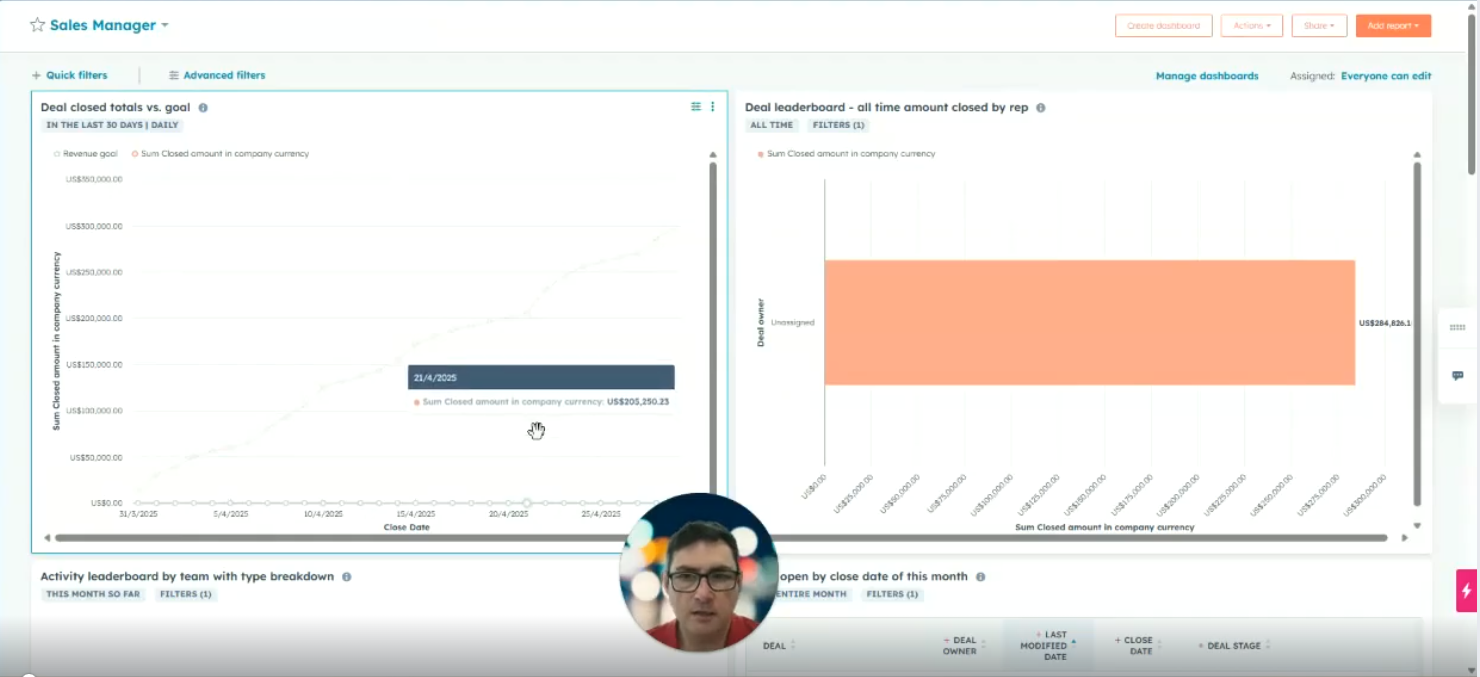3 min read
How to Use HubSpot to Drive Growth (Without Drowning in Dashboards)
Bradley Michel
:
Nov 4, 2025 9:59:59 AM
You’ve heard it before: "HubSpot will transform your business."
Then you log in and think, "What am I even looking at?"
That right there is the problem. Too many companies treat HubSpot like a Swiss Army knife they never unfold. They spend a fortune, then use it like an expensive address book.HubSpot is just a tool. Growth only happens when you use it with purpose. When data becomes insight. And insight becomes action.
So let's show you how to turn HubSpot into a real growth engine.
1. Stop Treating HubSpot Like Admin Software
If your team only uses HubSpot to log emails and track deals, you’ve missed the point. That’s like buying a Ferrari to store groceries in the trunk.
Scenario: At a typical SaaS company, the CRM might have 10 custom dashboards. But if none of them answer real business questions, no one uses them. Once dashboards are rebuilt around one prompt—"What decision could we make from this?"—teams start making faster, smarter moves.
Try this:
-
Look at your dashboard and ask: "What decisions could we make today from this data?"
-
If the answer is "none," rebuild it.
-
Every automation, dashboard, or workflow should start with a question like:
-
"Where are leads falling off?"
-
"What’s clogging our pipeline?"
-
"Which marketing efforts lead to actual deals?"
-
If it’s not helping you answer these, it’s just noise.
2. Map the Customer Journey, Then Build HubSpot Around It
Most teams start with HubSpot setup.
Smart teams start with the customer journey.
Example: A mid-sized services company maps their journey and realizes that after a form fill, leads wait days before hearing from anyone. Why? Because no one "owns" the next step. Fixing that one gap shortens their sales cycle dramatically.
Action:
-
Sketch your customer journey on one sheet.
-
Ask:
-
What happens when someone fills out a form?
-
Who owns each follow-up?
-
Where does data automatically move? Where does it die?
-
When you build around touchpoints, not tools, your CRM starts telling a story.
3. Automate the Boring Stuff (Not the Human Stuff)
Automation doesn’t mean removing people. It means removing friction.
Scenario: A growing team gets dozens of new leads weekly, but they sit in a queue. They add one automation: form fill → assign rep → send intro email → create task → alert manager after 48 hours if untouched. Conversion rates go up.
Try this:
-
Write down every task your team repeats twice a week or more.
-
Pick three. Automate them.
-
Start with lead assignment, follow-up nudges, meeting scheduling.
That’s not just time-saving. That’s revenue protection.
4. Get Obsessive About Data Hygiene
You can’t scale with dirty data. Full stop.
Scenario: A B2B team finds different reps updating lifecycle stages differently. One logs "Opportunity" for a booked demo, another for any email reply. Reports get messy. Budgets are based on fiction.
Fix it:
-
Create a shared definition for every lifecycle stage and property.
-
Schedule a monthly Data Health Check:
-
Duplicates
-
Missing stages
-
Contacts with no owners
-
Dead deals left open
-
Good data = smart decisions. Bad data = wishful thinking.
5. Train Like It’s a Product Launch
HubSpot only works when people use it. Most don’t.
Scenario: One brand launches HubSpot with a single onboarding video. Six months later, most users haven’t logged in. Now compare that to a team that treats it like a product launch:
-
Internal emails: "What HubSpot means for you"
-
Team contests: Most contacts cleaned up
-
Micro-trainings: 15 min, role-specific
-
Quarterly adoption awards
Adoption soars. Engagement follows. Growth happens.
Do this:
-
Treat onboarding like a campaign.
-
Short, relevant, and role-based.
-
Make adoption visible and rewarding.
6. Build a Quarterly Growth Loop
You can’t "set and forget" your HubSpot.
What high-performing teams do: Every 90 days they:
-
Kill the workflows no one uses
-
Replace spreadsheets with automation
-
Review reports that didn't lead to decisions
This isn’t about using more features. It’s about tightening the feedback loop between insight and action.
Ask each quarter:
-
What needs pruning?
-
Where are we still patching with spreadsheets?
-
Which reports led to action—and which didn’t?
7. Tie It All Back to Revenue
Here’s the test: Can you connect every campaign, every form, every email back to revenue?
If not, you’re flying blind.
Example: One team cuts 70% of their marketing reports. They keep three: Pipeline by source, revenue by campaign, and cost per acquisition. Suddenly, marketing has a seat at the revenue table.
Your move:
-
Use Campaigns, Deal Attribution, Lifecycle Stages.
-
Report on revenue-influenced, not just opens or clicks.
-
Align sales and marketing around pipeline—not content output.
The Bottom Line
HubSpot won’t grow your business. You will—if you use it to:
-
Turn questions into dashboards.
-
Turn gaps into automations.
-
Turn data into decisions.
If you treat it like admin software, you’ll get admin results. If you treat it like a growth system, you’ll get growth.
And if you build with clarity, you’ll build momentum.
Enjoyed this blog?
Here's some others we think you'll love
How to Drive CRM User Adoption That Lasts
Most UK businesses don’t fail at CRM because of bad systems. They fail because people never truly buy in. Real adoption isn’t about dashboards or...

Is Your CRM Hurting Sales? Discover How to Re-align
Understanding the Importance of CRM Alignment In the hustle and bustle of modern business, a CRM system should be your ally, not your adversary....

